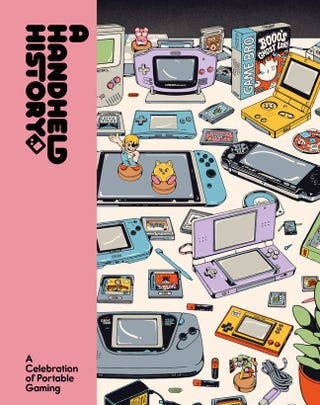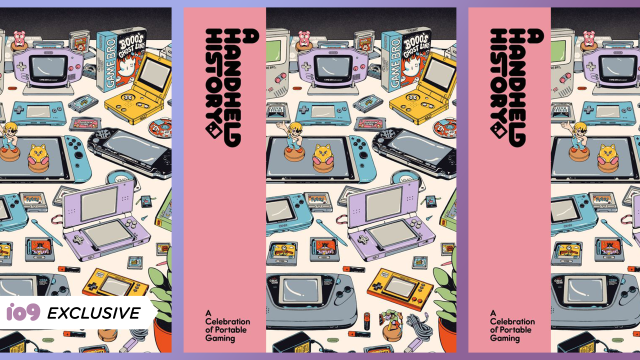Lost in Cult and Retro Dodo have collaborated to assemble dozens of essays on the art of the handheld device. From the hardware to the games themselves, A Handheld History: A Celebration of Portable Gaming is a gorgeous introspection into the decades of gaming that many of us remember from long rides on trains, planes, and automobiles. The interior is full of gorgeous photos and illustrations, and the entire book is a loving look at the screens we spent hours crouched over.
io9 presents an excerpt from the book written by Brandon Saltalamacchia, the founder of Retro Dodo. He talks about the Game Boy Color and what it meant to him as a child, and even now. From discarded AA batteries to plug-in overhead lights, read on for an ode to the ubiquitous devices of the ‘90s and early 2000s.

Game Boy Color
By Brandon Saltalamacchia
I have a very special place in my heart for the Game Boy Color. It was the first handheld console that I ever owned and it single-handedly got me to where I am today. It sparked my love for video games as a child, it motivated me to start my career in the games industry as a young man, and it eventually pushed me over the edge to leave my full-time job to grow Retro Dodo with nothing but a little bit of pocket money and a boatload of passion.
Handheld consoles have affected millions of peoples lives, and I am just one of them. What I am trying to say is that the Game Boy Color made this book that you are holding today possible — crazy, right? Some of my best childhood moments revolve around this incredible piece of technology, so much so that it’s actually linked to some of my earliest memories.
I remember vividly opening up Pokémon Yellow for my 8th birthday — I was so excited that I remember my little chubby 4 foot frame was pumped with adrenaline. The first thing I did was rip the box to shreds (I now regret that decision after seeing the prices of a boxed Pokémon Yellow on eBay), blow the imaginary dust out of the new cartridge, slot it into my turquoise Game Boy Color, and pull out the over-sized gaming guide that I bought with my own pocket money the week before. I’ll never forget that day.
The Game Boy Color launched in October 1998, and, although it wasn’t really mind-blowing when you look at how the line of Game Boys evolved over time, it was the first glimpse at Nintendo’s take on colour screens for their portable devices. Admittedly, Sega and Atari got there first, but Nintendo had the advantage of the Game Boy Color being far more portable, while also allowing gamers to use their old library of Game Boy cartridges, making it more appealing for parents who already forked out on the original DMG model. Nintendo knew what it was doing!
Unfortunately, the new colour screen was not backlit, but with its new display and brand new colour games, it was enough to fend off the competition. The Neo Geo Pocket and Bandai’s WonderSwan (which became its closest competition) saw just how popular the console was and decided to release their very own consoles with colour screens shortly after in order to compete — the Neo Geo Pocket Color and the WonderSwan Color. As you can imagine, they didn’t come close to Nintendo’s sales.
Shortly after the launch of the Game Boy Color, Nintendo released Pokémon Gold & Silver into the wild, and it felt like the world wasn’t ready for what was about to happen. The game sold over 23 million units worldwide, making it one of the best selling Nintendo games of all time.
I remember seeing long lines of gamers queuing to get a copy. The local parks were filled with trading cables and Pokémon were being traded for absurd things — I saw a kid trade three Beyblades and a bag of sweets for a Mareep, which, for those of you that don’t know, is one of the most common Pokémon in the game and happens to look like a sheep. Unlucky, buddy.
Nintendo completely nailed the marketing and the branding of the Game Boy Color, coercing practically every kid into wanting one through constant TV commercials and advertisements in magazines. It felt as if Toys ‘R Us was covering every promotional shelf with Game Boy products too — parents had nowhere to hide from Nintendo’s aggressive marketing strategy.
The new curved shell combined with the colour screen, and the need for only two AA batteries to power it, is what helped push the $US69 handheld into many households. It was also one of the first handheld consoles to be absolutely pounded with cheap, crazy-looking peripherals. Yes, the Game Boy DMG started this obscene market, but the Game Boy Color is what took it to a whole new level, featuring all kinds of different magnifiers, wormlights, grips, speakers, and battery packs. Not to mention the special branded editions of the console.
The way to tell if your friends at school had wealthy parents wasn’t the fact that they had a brand new Teenage Mutant Ninja Turtles backpack, and Buzz Lightyear sunglasses far too big for their head; it was actually showcased by how big and ugly their Game Boy Color looked due to the sheer amount of accessories that were attached to it – not to mention the status of having a special branded edition of the handheld under all that extra gear.
At this moment the world knew who Nintendo was, even if they had never touched a games console in their life. For me, and many gamers worldwide, it was the moment that the handheld gaming industry became mainstream. It may only have been a simple upgrade from the original, but it just goes to show what a difference a colour screen can make.
“Game Boy Color” from A Handheld History: A Celebration of Portable Gaming by Brandon Saltalamacchia is reprinted with permission from Harper Collins.
A Handheld History: A Celebration of Portable Gaming will be available October 17. Preorder here.
Want more io9 news? Check out when to expect the latest Marvel, Star Wars, and Star Trek releases, what’s next for the DC Universe on film and TV, and everything you need to know about the future of Doctor Who.
